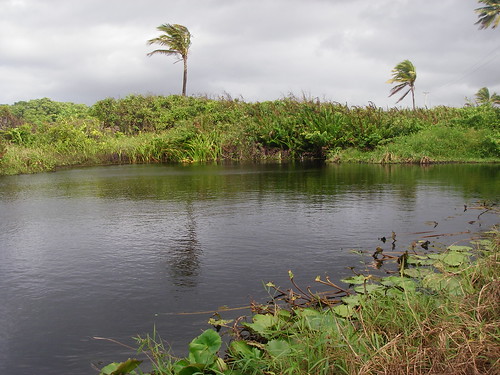The Abandoned Fieldstation
14th January 2009:
Thirty minutes’ walk from the Beach Facility, I came to an open part of the occluded Nariva River, which runs parallel to the Manzanilla-Mayaro Road. Or perhaps it was one of the many canals which run through the swamp.
Perhaps there would be manatees in these stretches of water, lined as they are with a nibbled growth of reeds and waterlilies. But with only twenty-odd manatees left in the entire area, the chance of a random encounter this close to the road was rather slim.
A guy called Ramish—from a road-clearing crew which had nearly run me over with their big orange digger—crossed the road to talk to me. He offered me a cough sweet and warned me about bandits hiding in the bushes. He also mentioned alligators lurking in the swamp.
The alligators were news to me. I wondered how they and the manatees get on in their shared habitat. Adult manatees are probably too big for an alligator to tackle, but what about the calves? Do mother manatees have a fierce side which I don’t know about? Or maybe their slow movements don’t trigger the ‘gators reflexes?
About twenty-five minutes after leaving the stretch of open water behind me, I finally reached the Manatee Field Station. As expected, it was deserted. There was no sign of any recent human activity. The gate hung open and the faded ‘Entry By Permit Only’ sign was practically an invitation: “get your manatees here!” According to Mr. Douglas, manatees are a delicacy, tasting like beef which is rare and expensive here.
Was I too late? Had the Manatee Conservation Trust been disbanded?
I turned to walk back. Two guys painting a wall at one of the few houses on the opposite side of the road beckoned me over and I went to talk to them.
The field station was indeed abandoned, but one of the men assured me that the manatees were safe.
“They are further upriver,” he said. “They breed there.”
“But nobody is watching them. Aren’t they hunted?”
He shook his head. “Oh no, people are watching. Nobody can come out with them!”
I liked that.
I stopped at d’Hammerhead Bar for a brunch of bake & shark and got talking to the owner—the first time I’d seen him as he usually has business elsewhere. Within five minutes of mentioning the manatees, he was on his mobile to a ranger friend who usually came to the bar for lunch. He was on his way over.
The man, who introduced himself as ‘Truckman’, had worked as a forest ranger for twenty-two years. He promised to pick me up at Dougie’s at ten the next morning. I could hardly believe my luck, but I noticed that he seemed distracted.
Obligations again.
“Really, I do not want to interfere with your work,” I said.
Truckman muttered something noncommittal. And then he told me about the monkeys.
Fifteen dead howler monkeys had been found in one week alone. They had sent a sample to the lab and were waiting for results. Yellow fever was suspected.
One sample?
I recalled the mess the Brits and Americans are making when sampling dead waterfowl for H5N1 Influenza (suspending the samples in saline or broth, to ensure extra-fast degradation of viral RNA) and wondered what tests would be used to confirm yellow fever. Even if the tests were robust, one sample wouldn’t mean much: perhaps they had found the only monkey to die of old age.
“Better to sample the lot,” I muttered.
Truckman bade his good-byes and I walked down the path to the L’Ebranche River. I hadn’t seen Ryan and thought it best to leave a message with his friends, lest he thought I had turned into some incomprehensible phone stalker.
The fishermen were just landing their catch: crate upon crate of snappers but also tiny sharks and tuna, none longer than my arm. The estuary was a haven for juvenile fish. Even with next-to-zero visibility, the waters here are rich. The beach and mangroves were dotted with black vultures (Coragyps atratus, locally known as kobos), expectantly waiting for their share. Dogs patrolled the beach, fat and happy.
People came seemingly from nowhere to buy fish. Some of it was grilled right next to the landing area, on corrugated metal sheets which had been pulled across a small fire. Somebody tossed a bundle of fish innards into the river, and a large striped pufferfish came so close to the surface that I could see it feed. Else there would be a splash and the morsels disappeared into the tea-like water without a trace—cigarette butts and all.
Ryan was there, and so was Charlie. They gave me a lift home.
“I would like to set up a co-operative,” Charlie mused. “We could sell much more fish that way—we struggle to sell it. But the government isn’t interested. The government doesn’t care about this area, only about the heavy industry in the east.”
He had a point; his was an old complaint. The government doesn’t think in terms of small-scale businesses—be they fisheries co-operatives, women’s collectives or eco-tourism outfits. I had heard of one such outfit from second-hand references: ‘South East Ecotours’ were founded in the nineties to bring ecotourism to Nariva. But the fact is that almost all tourists visiting the area come with tour operators based in Port of Spain.
They bring no business to the local community.
Tags: Americas, manatees, Manzanilla, Nariva Swamp, Travel, Trinidad, Tag Index